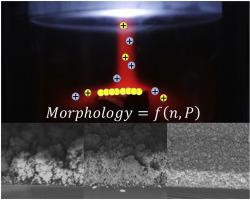当前位置:
X-MOL 学术
›
J. Aerosol Sci.
›
论文详情
Our official English website, www.x-mol.net, welcomes your feedback! (Note: you will need to create a separate account there.)
Nanoparticle gas phase electrodeposition: Fundamentals, fluid dynamics, and deposition kinetics
Journal of Aerosol Science ( IF 4.5 ) Pub Date : 2021-01-01 , DOI: 10.1016/j.jaerosci.2020.105652 Leslie Schlag , Nishchay A. Isaac , Helene Nahrstedt , Johannes Reiprich , Adriana Ispas , Thomas Stauden , Jörg Pezoldt , Andreas Bund , Heiko O. Jacobs
Journal of Aerosol Science ( IF 4.5 ) Pub Date : 2021-01-01 , DOI: 10.1016/j.jaerosci.2020.105652 Leslie Schlag , Nishchay A. Isaac , Helene Nahrstedt , Johannes Reiprich , Adriana Ispas , Thomas Stauden , Jörg Pezoldt , Andreas Bund , Heiko O. Jacobs

|
Abstract This communication uncovers missing fundamental elements and an expanded model of gas phase electrodeposition; a relatively new and in large parts unexplored process, which combines particle generation, transport zone and deposition zone in an interacting setup. The process enables selected area deposition of charged nanoparticles that are dispersed and transported by a carrier gas at atmospheric pressure conditions. Two key parameters have been identified: carrier gas flow rate and spark discharge power. Both parameters affect electrical current carried by charged species, nanoparticle mass, particle size and film morphology. In combination, these values enable to provide an estimate of the gas flow dependent Debye length. Together with Langmuir probe measurements of electric potential and field distribution, the transport can be described and understood. First, the transport of the charged species is dominated by the carrier gas flow. In close proximity, the transport is electric field driven. The transition region is not fixed and correlates with the electric potential profile, which is strongly dependent on the deposition rate. Considering the film morphology, the power of the discharge turns out to be the most relevant parameter. Low spark power combined with low gas flow leads to dendritic film growth. In contrast, higher spark power combined with higher gas flow produces compact layers.
中文翻译:

纳米粒子气相电沉积:基础知识、流体动力学和沉积动力学
摘要 本次交流揭示了缺失的基本元素和气相电沉积的扩展模型;一种相对较新且大部分未经探索的过程,它将粒子生成、传输区和沉积区结合在一个相互作用的设置中。该工艺能够在大气压条件下通过载气分散和运输带电纳米颗粒的选定区域沉积。已经确定了两个关键参数:载气流速和火花放电功率。这两个参数都会影响带电物质携带的电流、纳米颗粒质量、颗粒尺寸和薄膜形态。结合起来,这些值能够提供依赖于气流的德拜长度的估计。连同朗缪尔探针测量电位和场分布,可以描述和理解传输。首先,带电物质的传输受载气流支配。在附近,传输是电场驱动的。过渡区域不是固定的并且与电势分布相关,而电势分布强烈依赖于沉积速率。考虑到薄膜形态,放电功率是最相关的参数。低火花功率与低气流相结合导致树枝状薄膜生长。相比之下,较高的火花功率与较高的气流相结合会产生致密的层。这在很大程度上取决于沉积速率。考虑到薄膜形态,放电功率是最相关的参数。低火花功率与低气流相结合导致树枝状薄膜生长。相比之下,较高的火花功率与较高的气流相结合会产生致密的层。这在很大程度上取决于沉积速率。考虑到薄膜形态,放电功率是最相关的参数。低火花功率与低气流相结合导致树枝状薄膜生长。相比之下,较高的火花功率与较高的气流相结合会产生致密的层。
更新日期:2021-01-01
中文翻译:

纳米粒子气相电沉积:基础知识、流体动力学和沉积动力学
摘要 本次交流揭示了缺失的基本元素和气相电沉积的扩展模型;一种相对较新且大部分未经探索的过程,它将粒子生成、传输区和沉积区结合在一个相互作用的设置中。该工艺能够在大气压条件下通过载气分散和运输带电纳米颗粒的选定区域沉积。已经确定了两个关键参数:载气流速和火花放电功率。这两个参数都会影响带电物质携带的电流、纳米颗粒质量、颗粒尺寸和薄膜形态。结合起来,这些值能够提供依赖于气流的德拜长度的估计。连同朗缪尔探针测量电位和场分布,可以描述和理解传输。首先,带电物质的传输受载气流支配。在附近,传输是电场驱动的。过渡区域不是固定的并且与电势分布相关,而电势分布强烈依赖于沉积速率。考虑到薄膜形态,放电功率是最相关的参数。低火花功率与低气流相结合导致树枝状薄膜生长。相比之下,较高的火花功率与较高的气流相结合会产生致密的层。这在很大程度上取决于沉积速率。考虑到薄膜形态,放电功率是最相关的参数。低火花功率与低气流相结合导致树枝状薄膜生长。相比之下,较高的火花功率与较高的气流相结合会产生致密的层。这在很大程度上取决于沉积速率。考虑到薄膜形态,放电功率是最相关的参数。低火花功率与低气流相结合导致树枝状薄膜生长。相比之下,较高的火花功率与较高的气流相结合会产生致密的层。



























 京公网安备 11010802027423号
京公网安备 11010802027423号